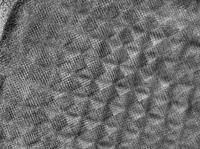Home > Press > University of Pennsylvania engineers discover natural 'workbench' for nanoscale construction
 |
| Lattice image of a grain of composition fow which both chessboard and diamond contrast are apparent. The scale bars are 20nm. Credit: University of Pennsylvania |
Abstract:
Engineers at the University of Pennsylvania have taken a step toward simplifying the creation of nanostructures by identifying the first inorganic material to phase separate with near-perfect order at the nanometer scale. The finding provides an atomically tuneable nanocomposite "workbench" that is cheap and easy to produce and provides a super-lattice foundation potentially suitable for building nanostructures.
University of Pennsylvania engineers discover natural 'workbench' for nanoscale construction
Philadelphia, PA | Posted on July 17th, 2007The findings appear in the August issue of Nature Materials.
Alerted by an unusual diffraction effect of a common ceramic material, researchers used imaging to identify a two-phase structural pattern ideal as the first step towards nanodevice construction. Practical application of nanotechnology will rely upon engineering's ability to manipulate atoms and molecules into long-range order to produce materials with desired functionalities. The Penn findings provide a simpler method for the ordering of composite parts on the nanometer scale, which is integral to the incorporation of nano-objects such as particles and wires that make up nanodevices.
The material used in the Penn study is an ionically- conductive, crystalline ceramic (Nd2/3-xLi3x)TiO3 that engineers observed with transmission electron microscopy. The powdered perovskite exhibited two distinct patterns at the atomic scale with identical periodicity: a nanoscale chessboard pattern and a diamond pattern that indicated periodic separation into two phases within the structure. This spontaneous separation of phases could present a new foundation on which to build nanodevice technology. This material - made using standard and easily reproducible ceramic processing methods - represents the formation of a spontaneous microscopic surface controlled on the nanoscale with atomic precision.
Further study revealed that the separation of the structure into two distinct phases was a result of the oxide separating into lithium rich squares and lithium poor stripes. By varying the amount of lithium and neodymium, two ingredients in the ceramic powder, engineers controlled the length and spacing of the alternating phases, thereby tuning the workbench upon which nanodevices could be built.
On a larger-than-atomic scale, the research extends science's knowledge of the properties of a most common oxide structure type, currently used for superconducting materials, magnetoresistive materials and ferroelectrics.
"This study represents great potential for the use of standard ceramic processing methods for nanotechnology," said Peter K. Davies, chair of the Department of Materials Science and Engineering at Penn. "The phase separation occurs spontaneously, providing two phases whose dimensions both extend into the nanometer scale. This unique feature could lead to its application as a template for the assembly of nanostructures or molecular monolayers."
The research was performed by Davies and Beth S. Guiton of the Department of Materials Science and Engineering in Penn's School of Engineering and Applied Science.
The research was supported by the National Science Foundation.
####
For more information, please click here
Contacts:
Jordan Reese
215-573-6604
Copyright © University of Pennsylvania
If you have a comment, please Contact us.Issuers of news releases, not 7th Wave, Inc. or Nanotechnology Now, are solely responsible for the accuracy of the content.
| Related News Press |
Discoveries
![]() Researchers develop molecular qubits that communicate at telecom frequencies October 3rd, 2025
Researchers develop molecular qubits that communicate at telecom frequencies October 3rd, 2025
![]() Next-generation quantum communication October 3rd, 2025
Next-generation quantum communication October 3rd, 2025
![]() "Nanoreactor" cage uses visible light for catalytic and ultra-selective cross-cycloadditions October 3rd, 2025
"Nanoreactor" cage uses visible light for catalytic and ultra-selective cross-cycloadditions October 3rd, 2025
Materials/Metamaterials/Magnetoresistance
![]() First real-time observation of two-dimensional melting process: Researchers at Mainz University unveil new insights into magnetic vortex structures August 8th, 2025
First real-time observation of two-dimensional melting process: Researchers at Mainz University unveil new insights into magnetic vortex structures August 8th, 2025
![]() Researchers unveil a groundbreaking clay-based solution to capture carbon dioxide and combat climate change June 6th, 2025
Researchers unveil a groundbreaking clay-based solution to capture carbon dioxide and combat climate change June 6th, 2025
![]() A 1960s idea inspires NBI researchers to study hitherto inaccessible quantum states June 6th, 2025
A 1960s idea inspires NBI researchers to study hitherto inaccessible quantum states June 6th, 2025
![]() Institute for Nanoscience hosts annual proposal planning meeting May 16th, 2025
Institute for Nanoscience hosts annual proposal planning meeting May 16th, 2025
Announcements
![]() Rice membrane extracts lithium from brines with greater speed, less waste October 3rd, 2025
Rice membrane extracts lithium from brines with greater speed, less waste October 3rd, 2025
![]() Researchers develop molecular qubits that communicate at telecom frequencies October 3rd, 2025
Researchers develop molecular qubits that communicate at telecom frequencies October 3rd, 2025
![]() Next-generation quantum communication October 3rd, 2025
Next-generation quantum communication October 3rd, 2025
![]() "Nanoreactor" cage uses visible light for catalytic and ultra-selective cross-cycloadditions October 3rd, 2025
"Nanoreactor" cage uses visible light for catalytic and ultra-selective cross-cycloadditions October 3rd, 2025
|
|
||
|
|
||
| The latest news from around the world, FREE | ||
|
|
||
|
|
||
| Premium Products | ||
|
|
||
|
Only the news you want to read!
Learn More |
||
|
|
||
|
Full-service, expert consulting
Learn More |
||
|
|
||








